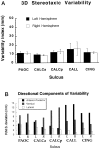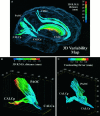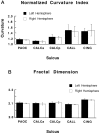Three-dimensional statistical analysis of sulcal variability in the human brain
- PMID: 8753887
- PMCID: PMC6578992
- DOI: 10.1523/JNEUROSCI.16-13-04261.1996
Three-dimensional statistical analysis of sulcal variability in the human brain
Abstract
Morphometric variance of the human brain is qualitatively observable in surface features of the cortex. Statistical analysis of sulcal geometry will facilitate multisubject atlasing, neurosurgical studies, and multimodality brain mapping applications. This investigation describes the variability in location and geometry of five sulci surveyed in each hemisphere of six postmortem human brains placed within the Talairach stereotaxic grid. The sulci were modeled as complex internal surfaces in the brain. Heterogeneous profiles of three-dimensional (3D) variation were quantified locally within individual sulci. Whole human heads, sectioned at 50 micrometer, were digitally photographed and high-resolution 3D data volumes were reconstructed. The parieto-occipital sulcus, the anterior and posterior rami of the calcarine sulcus, the cingulate and marginal sulci, and the supracallosal sulcus were delineated manually on sagittally resampled sections. Sulcal outlines were reparameterized for surface comparisons. Statistics of 3D variation for arbitrary points on each surface were calculated locally from the standardized individual data. Additional measures of surface area, extent in three dimensions, surface curvature, and fractal dimension were used to characterize variations in sulcal geometry. Paralimbic sulci exhibited a greater degree of anterior-posterior variability than vertical variability. Occipital sulci displayed the reverse trend. Both trends were consistent with developmental growth patterns. Points on the occipital sulci displayed a profile of variability highly correlated with their 3D distance from the posterior commissure. Surface curvature was greater for the arched paralimbic sulci than for those bounding occipital gyri in each hemisphere. On the other hand, fractal dimension measures were remarkably similar for all sulci examined, and no significant hemispheric asymmetries were found for any of the selected spatial and geometric parameters. Implications of cortical morphometric variability for multisubject comparisons and brain mapping applications are discussed.
Figures










Similar articles
-
Cortical variability and asymmetry in normal aging and Alzheimer's disease.Cereb Cortex. 1998 Sep;8(6):492-509. doi: 10.1093/cercor/8.6.492. Cereb Cortex. 1998. PMID: 9758213
-
Sulcal variability in the Alzheimer's brain: correlations with cognition.Neurology. 1998 Jan;50(1):145-51. doi: 10.1212/wnl.50.1.145. Neurology. 1998. PMID: 9443471
-
High-resolution random mesh algorithms for creating a probabilistic 3D surface atlas of the human brain.Neuroimage. 1996 Feb;3(1):19-34. doi: 10.1006/nimg.1996.0003. Neuroimage. 1996. PMID: 9345472
-
Automated extraction and variability analysis of sulcal neuroanatomy.IEEE Trans Med Imaging. 1999 Mar;18(3):206-17. doi: 10.1109/42.764891. IEEE Trans Med Imaging. 1999. PMID: 10363699 Review.
-
[Echographic aspects of cerebral sulci in the ante- and perinatal period].J Radiol. 1988 Aug-Sep;69(8-9):521-32. J Radiol. 1988. PMID: 3057186 Review. French.
Cited by
-
Accuracy and applications of group MEG studies using cortical source locations estimated from participants' scalp surfaces.Hum Brain Mapp. 2003 Nov;20(3):142-7. doi: 10.1002/hbm.10133. Hum Brain Mapp. 2003. PMID: 14601140 Free PMC article.
-
Identifying homologous anatomical landmarks on reconstructed magnetic resonance images of the human cerebral cortical surface.J Anat. 1998 Nov;193 ( Pt 4)(Pt 4):559-71. doi: 10.1046/j.1469-7580.1998.19340559.x. J Anat. 1998. PMID: 10029189 Free PMC article.
-
Diffusion MRI harmonization via personalized template mapping.Hum Brain Mapp. 2024 Apr;45(5):e26661. doi: 10.1002/hbm.26661. Hum Brain Mapp. 2024. PMID: 38520363 Free PMC article.
-
Three-dimensional mapping of gyral shape and cortical surface asymmetries in schizophrenia: gender effects.Am J Psychiatry. 2001 Feb;158(2):244-55. doi: 10.1176/appi.ajp.158.2.244. Am J Psychiatry. 2001. PMID: 11156807 Free PMC article.
-
Whole brain diffeomorphic metric mapping via integration of sulcal and gyral curves, cortical surfaces, and images.Neuroimage. 2011 May 1;56(1):162-73. doi: 10.1016/j.neuroimage.2011.01.067. Epub 2011 Jan 31. Neuroimage. 2011. PMID: 21281722 Free PMC article.
References
-
- Andreasen NC, Arndt S, Swayze V, Cizadlo T, Flaum M, O’Leary D, Ehrhardt JC, Yuh WTC. Thalamic abnormalities in schizophrenia visualized through magnetic resonance image averaging. Science. 1994;266:294–298. - PubMed
-
- Bailey P, von Bonin G (1951) The isocortex of man. Urbana: University of Illinois.
-
- Bookstein FL (1995) Proposal for a biometrics of the cortical surface: a statistical method for relative surface distance metrics. In: Proceedings of the SPIE Conference on Vision Geometry, Vol 2573, pp 312–323.
-
- Bookstein F, Chernoff B, Elder R, Humphries J, Smith G, Strauss R (1985) Morphometrics in evolutionary biology, Special publication 15. Academy of Natural Sciences of Philadelphia.
-
- Burzaco J. Stereotaxic pallidotomy in extrapyramidal disorders. Appl Neurophysiol. 1985;48:283–287. - PubMed
Publication types
MeSH terms
Grants and funding
LinkOut - more resources
Full Text Sources
Other Literature Sources
